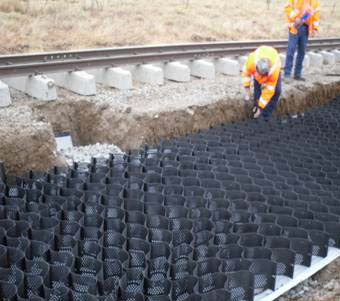The February 2015 issue of Geofabrics Journal, published by Geofabrics Australasia, includes a significant focus on railway engineering, including project notes and the many geotechnical solutions within them that utilize geosynthetics. The rounded view of rail works profiles materials, issues of track and subsoil integrity, and Australia’s infrastructure needs—all of which can be extended to understanding geotechnical solutions in similar projects elsewhere in the world.
The issue opens with a look at how the Australian Rail Track Corporation Ltd. (ARTC) addressed erosion pumping risk with tracks in New South Wales (NSW). A micro-porous filter, sandwiched between two layers of bidim® nonwoven geotextile, was installed at the ballast interface of trouble track sections. The geotextile separation and porous filter guarded against excessive water infiltration. The Tracktex™ materials kept the subsoils from eroding due to infiltration as well as from pumping from the heavy rail loads passing overhead.
MORE GEO: Lightweight Foamed Concrete Subgrade for Heavy Haul Railway
GEOSYNTHETICS IN RAILWAY ENGINEERING
 Another article looks at the hybrid solution of geotextile separation used in combination with Tensar® TX 160 geogrid reinforcement. The combination of the geosynthetics here greatly reduced the amount of fill needed for a project along the Dandenong Rail Line.
Another article looks at the hybrid solution of geotextile separation used in combination with Tensar® TX 160 geogrid reinforcement. The combination of the geosynthetics here greatly reduced the amount of fill needed for a project along the Dandenong Rail Line.
Importing special fill for the full installation would have been prohibitively expensive.
One of the great advantages of geosynthetic technologies is the reduced need for traditional aggregate fills. Reinforcement and separation materials have delivered significant savings and sustainability benefits, as aggregate processing, transport, and installation is environmentally intensive and costly (both for material acquisition and in requiring longer, more complex installation practices).
Pre-filled gabions are profiled from ARTC’s Northern Railway Line too. The solution, which involved a 124m long, 4m high retaining wall, was used to repair a severely eroded slope. The pre-filled gabions allowed for efficient construction in limited space on a tight timeline.
Other stories profile the use of rockfall netting in track protection, a look back at a 20-year-old Queensland Rail project, and a recent project in which Queensland Rail used a geocellular (Geoweb®) to stabilize subgrade soils in a monsoon-affected area.











